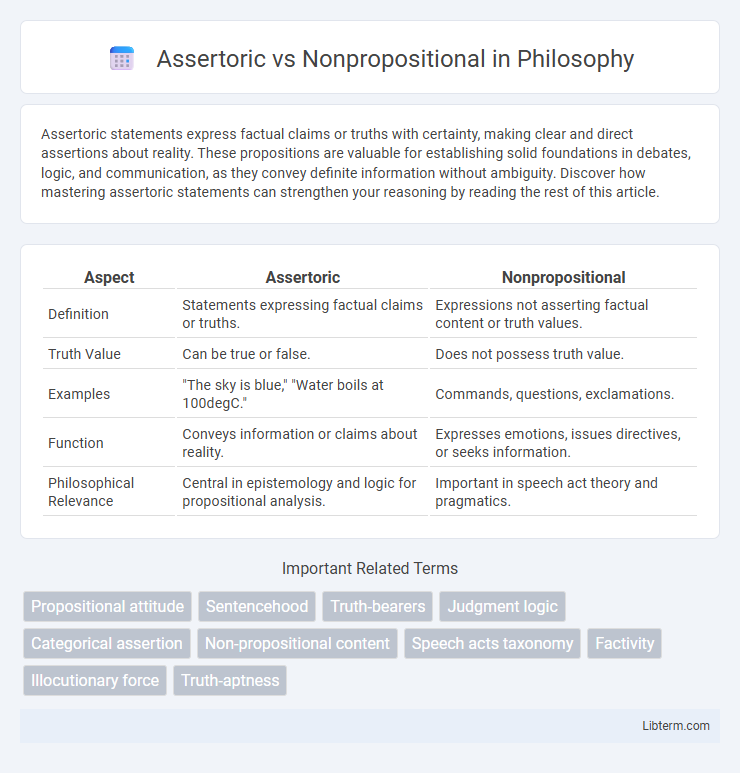Assertoric statements express factual claims or truths with certainty, making clear and direct assertions about reality. These propositions are valuable for establishing solid foundations in debates, logic, and communication, as they convey definite information without ambiguity. Discover how mastering assertoric statements can strengthen your reasoning by reading the rest of this article.
Table of Comparison
| Aspect | Assertoric | Nonpropositional |
|---|---|---|
| Definition | Statements expressing factual claims or truths. | Expressions not asserting factual content or truth values. |
| Truth Value | Can be true or false. | Does not possess truth value. |
| Examples | "The sky is blue," "Water boils at 100degC." | Commands, questions, exclamations. |
| Function | Conveys information or claims about reality. | Expresses emotions, issues directives, or seeks information. |
| Philosophical Relevance | Central in epistemology and logic for propositional analysis. | Important in speech act theory and pragmatics. |
Introduction to Assertoric and Nonpropositional Statements
Assertoric statements express propositions that assert something as true or false, providing clear truth values essential for logical analysis and reasoning. Nonpropositional statements, such as questions, commands, or exclamations, do not convey truth-apt content and therefore cannot be classified as true or false. Understanding the distinction between assertoric and nonpropositional statements is fundamental in semantics and the philosophy of language for analyzing meaning and communication.
Defining Assertoric Propositions
Assertoric propositions are statements that assert or deny something with a definite truth value, typically expressing factual information or claims subject to verification. Unlike nonpropositional utterances, assertoric propositions convey explicit content that can be evaluated as true or false, forming the basis for logical analysis and reasoning. Their defining feature is the commitment to the truth or falsity of the proposition's content, distinguishing them from questions, commands, or expressions of emotions.
Understanding Nonpropositional Expressions
Nonpropositional expressions convey meaning without asserting a truth value, differing from assertoric statements that affirm or deny propositions. Understanding nonpropositional language involves recognizing its functions in communication, such as expressing emotions, commands, or questions, which do not entail truth claims. These expressions play a crucial role in pragmatics and linguistic theory by highlighting how meaning extends beyond truth-conditional content.
Key Differences Between Assertoric and Nonpropositional
Assertoric statements assert a specific truth value, expressing propositions that can be definitively classified as true or false, such as factual claims or judgments. Nonpropositional content, including questions, commands, and exclamations, lacks a truth value and does not function to assert a fact or proposition. Key differences center on truth value presence, with assertoric statements serving as declarative assertions, while nonpropositional utterances perform other speech acts without conveying truth conditions.
The Role of Truth-Value in Assertoric Statements
Assertoric statements carry a truth-value that determines their truthfulness or falsity, serving as declarative propositions that assert facts or descriptions about reality. Nonpropositional utterances lack a truth-value and do not function to assert or deny something that can be true or false, often encompassing commands, questions, or expressions. The role of truth-value in assertoric statements is central, as it underpins logical analysis, truth conditions, and the capacity to engage in valid reasoning and argumentation.
Nonpropositional Language in Everyday Communication
Nonpropositional language encompasses gestures, facial expressions, and tone, which convey meaning without relying on explicit statements or propositions. In everyday communication, nonpropositional cues play a crucial role in expressing emotions, intentions, and social dynamics, often enhancing or contradicting spoken words. Understanding nonpropositional elements is essential for interpreting context and improving interpersonal interactions beyond literal language.
Philosophical Significance of Assertoric Discourse
Assertoric discourse asserts propositions with a truth value, forming the basis of logical reasoning and meaningful communication in philosophy. It enables the evaluation of statements as true or false, which is essential for critical analysis and knowledge acquisition. This form of discourse contrasts with nonpropositional utterances, which express emotions or commands without truth conditions, highlighting the central role of assertoric speech in epistemology and analytical philosophy.
Implications for Logic and Argumentation
Assertoric statements express propositions that can be definitively true or false, providing a clear basis for logical analysis and argument evaluation. Nonpropositional expressions, such as questions or commands, lack truth values, complicating their direct use in formal logic and argumentation frameworks. Understanding the distinction shapes how logical validity and soundness are assessed, emphasizing the role of assertoric content in constructing valid arguments and avoiding fallacies.
Applications in Linguistics and Semantics
Assertoric statements convey factual information and are pivotal in semantic analysis for determining truth conditions within natural language processing (NLP) applications. Nonpropositional utterances, such as questions, commands, or interjections, play critical roles in pragmatics and discourse analysis by influencing speaker intention and contextual interpretation. Linguistic models incorporate distinctions between assertoric and nonpropositional speech acts to enhance semantic role labeling, dialogue systems, and conversational AI accuracy.
Conclusion: Navigating Assertoric and Nonpropositional Usage
Understanding the distinction between assertoric and nonpropositional statements is crucial for effective argumentation and communication. Assertoric statements convey definitive claims that can be evaluated as true or false, forming the backbone of logical conclusions and evidence-based reasoning. Navigating the use of these statement types enhances clarity, allowing precise articulation of facts versus expressions of opinions or intentions.
Assertoric Infographic

 libterm.com
libterm.com